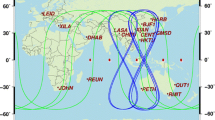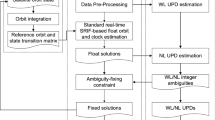Abstract
Aiming at regional services, the space segment of COMPASS (Phase I) satellite navigation system is a constellation of Geostationary Earth Orbit (GEO), Inclined Geostationary Earth Orbit (IGSO) and Medium Earth Orbit (MEO) satellites. Precise orbit determination (POD) for the satellites is limited by the geographic distribution of regional tracking stations. Independent time synchronization (TS) system is developed to supplement the regional tracking network, and satellite clock errors and orbit data may be obtained by simultaneously processing both tracking data and TS data. Consequently, inconsistency between tracking system and TS system caused by remaining instrumental errors not calibrated may decrease navigation accuracy. On the other hand, POD for the mixed constellation of GEO/IGSO/MEO with the regional tracking network leads to parameter estimations that are highly correlated. Notorious example of correlation is found between GEO’s orbital elements and its clock errors. We estimate orbital elements and clock errors for a 3GEO+2IGSO constellation in this study using a multi-satellite precise orbit determination (MPOD) strategy, with which clock error elimination algorithm is applied to separate orbital and clock estimates to improve numerical efficiency. Satellite Laser Ranging (SLR) data are used to evaluate User Ranging Error (URE), which is the orbital error projected on a receiver’s line-of-sight direction. Two-way radio-wave time transfer measurements are used to evaluate clock errors. Experimenting with data from the regional tracking network, we conclude that the fitting of code data is better than 1 m in terms of Root-Mean-Square (RMS), and fitting of carrier phase is better than 1 cm. For orbital evaluation, difference between computed receiver-satellite ranging based on estimated orbits and SLR measurements is better than 1 m (RMS). For clock estimates evaluation, 2-hour linear-fitting shows that the satellite clock rates are about 1.E-10 s/s, while receiver clock rates are about 1×10−13–1×10−12 s/s. For the 72-hour POD experiment, the average differences between POD satellite clock rates estimates and clock measurements based on TS system are about 1×10−13 s/s, and for receiver clock rates, the differences are about 1×10−15 s/s.
Similar content being viewed by others
References
Fisher S C, Ghassemi K. GPS IIF—The next generation. Proc IEEE, 1999, 87: 24–47
Huang Y, HU X G, Huang C, et al. Precise orbit determination of a maneuvered GEO satellite using CAPS ranging data. Sci China Ser G-Phys Mech Astron, 2008, 52: 346–352
Li Z G, Yang X H, Shi H L, et al. A new method for determination of satellite orbits by transfer. Sci China Ser G-Phys Mech Astron, 2009, 52: 384–392
Guo R, Hu X G, Tang B, et al. Precise orbit determination for geostationary satellites with multiple tracking techniques. Chin Sci Bull, 2010, 55: 687–692
Liu L. Dynamics of Satellite Orbit (in Chinese). Beijing: Higher Education Press, 1992
Zhou S S, Hu X G, Wu B. Orbit determination and prediction accuracy analysis for a regional tracking network. Sci China Phys Mech Astron, 2010, 53: 1130–1138
Wang J X. GPS Satellite Precise Orbit Determination and Positioning (in Chinese). Shanghai: Tongji University Press, 1997
Fan G Y. Error Theory and Foundation of Surveying Adjustment (in Chinese). Shanghai: Tongji University Press, 1998
Fang R X, Shi C, Wei N, et al. Real-time cycle-slip detection for quality control of GPS measurements. Geomat Info Sci Wuhan Univ, 2009, 34: 1094–1097
Choi K, Bilich A, Larson K M, et al. Modified sidereal filtering: Implications for high-rate GPS positioning. Geophys Res Lett, 2004, 31: L22608
Axelrad P, Larson K, Jones B. Use of the correct satellite repeat period to characterize and reduce site-specific multi-path errors. In: ION GNSS 18th International Technical Meeting of the Satellite Division, 13–16 Sep. 2005. Long Beach, CA: the Institution of Navigation, 2005. 2638–2648
Liu L, Zhu L F, Han C H, et al. The model of two-way radio time transfer between the earth and satellites and analysis of its experiment. Acta Astron Sin, 2009, 50: 189–196
Liu L, Han C H. Two way satellite time transfer and its error analysis. Prog Astron, 2004, 22: 219–226
Author information
Authors and Affiliations
Corresponding authors
Rights and permissions
About this article
Cite this article
Zhou, S., Hu, X., Wu, B. et al. Orbit determination and time synchronization for a GEO/IGSO satellite navigation constellation with regional tracking network. Sci. China Phys. Mech. Astron. 54, 1089–1097 (2011). https://doi.org/10.1007/s11433-011-4342-9
Received:
Accepted:
Published:
Issue Date:
DOI: https://doi.org/10.1007/s11433-011-4342-9




